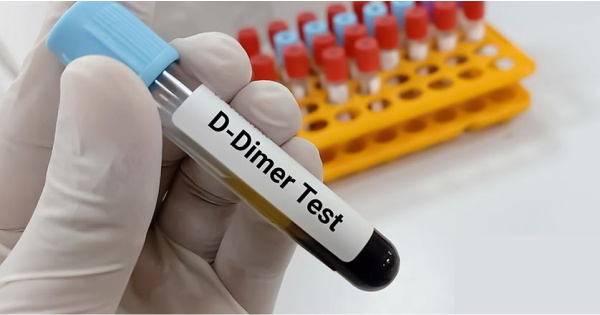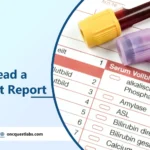Contents
Overview
D-dimer is a very commonly used blood test that helps your doctor determine or rule out suspected coagulation or clotting disorders. D-dimer is composed of 2 protein fragments held together by a cross-link. This is produced by the fragmentation of a blood clot.
Blood clotting is a necessary process that prevents you from losing too much blood when you are injured, but many conditions trigger the blood clot mechanism and fragmentation mechanism unnecessarily, without injury or requirement.
A D-dimer test may help your doctor find a blood clotting condition. Having a high D-dimer level in your blood can be a sign of a blood clotting disorder since the level of D-dimer can rise greatly when there’s significant formation and breakdown of blood clots in your body.
This test adds more value if done serially multiple times over the period.
What is a D-dimer test used for?
Doctors most often use D-dimer tests to help determine if someone has a blood clotting condition. These conditions include:
- Deep vein thrombosis (DVT or venous thrombosis): It is a condition where a blood clot develops in a vein deep in your body. The clot may partially or completely block blood flow through the vein. Most DVTs happen in your lower leg, thigh or pelvis, but they can also occur in other parts of your body, including your arm, brain, intestines, liver or kidney.
- Pulmonary embolism (PE): A pulmonary embolism is a blood clot in your lung that flows through your bloodstream from another part of your body (often your leg or arm). It then becomes lodged in the blood vessels of your lung.
- Disseminated intravascular coagulation (DIC): this condition causes too many blood clots to form in your body, which can cause organ damage and other serious complications.
- Coagulation abnormalities associated with COVID-19
Who is at risk of higher levels of D-dimer?
Other conditions and situations that can cause higher-than-normal levels of D-dimer include:
- Pregnancy.
- Heart disease.
- Recent major surgery.
- Trauma.
- Infection.
D-dimer levels also tend to rise in older people or in neonatal periods, and if you have rheumatoid arthritis, false-positive results may occur.
Who is at risk for developing blood clots?
Risk factors for developing inappropriate or abnormal blood clots include:
- Major surgery or experiencing trauma.
- Prolonged immobility, which can include sitting for long trips or prolonged bed rest.
- Taking birth control pills or hormone replacement therapy.
- Pregnancy or recent childbirth.
- A family history of blood clots or a specific condition, such as Factor V Leiden, Protein-C, protein-S deficiency disease, antiphospholipid syndrome or polycythemia vera.
- Certain types of cancer.
- Having coronavirus disease 2019 (COVID-19), or other Acute respiratory distress syndrome (ARDS)
- Hemolysis
- Inflammatory bowel disease
- Obesity.
- Smoking.
Why do I need a D-dimer test?
You may have you undergo a D-dimer test if you’re having symptoms of a blood clotting condition, which include:
- Deep vein thrombosis (DVT).
- Pulmonary embolism (PE).
- Disseminated intravascular coagulation (DIC).
- Stroke and Myocardial infarction.
- You are on certain medications where a regular check is required.
- Family history of coagulation disorders
- Risks described above.
All four disorders have different symptoms.
Symptoms of DVT
- Swelling of your leg or arm, which sometimes happens suddenly.
- Pain or tenderness in your leg, which may only happen when standing or walking.
- Warmth in the area of your leg or arm that’s swollen or hurts.
- Skin that is red or discoloured.
- Veins near the surface of your skin that are larger than usual.
Symptoms of PE
- Sudden shortness of breath (dyspnea) or fast breathing.
- Sharp chest pain often happens when you cough or move.
- Pain in your back.
- Coughing (sometimes with bloody spit or phlegm).
- Sweating more than you usually do.
- Fast heart rate (tachycardia).
- Feeling dizzy or fainting.
Symptoms of DIC
- Bleeding gums.
- Nausea and/or vomiting.
- Severe muscle pain and abdominal pain.
- Seizures.
- Peeing less than you usually do.
Symptoms of Stroke
- Sudden numbness or weakness in your face, arm or leg, especially on one side of your body.
- Sudden confusion, trouble speaking, or difficulty comprehending what someone is saying.
- Sudden difficulty seeing in one or both of your eyes.
- Sudden trouble walking.
- Sudden dizziness, loss of balance or lack of coordination.
- Sudden severe headache with no known cause.
Disclaimer:
This blog is for informational purposes only and should not be construed as advice or as a substitute for consulting a physician. It is not a substitute for medical advice or treatment from a healthcare professional.
Sources:
https://medlineplus.gov/lab-tests/d-dimer-test/
https://my.clevelandclinic.org/health/diagnostics/22045-d-dimer-test





